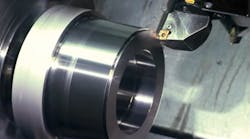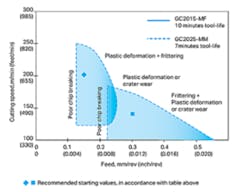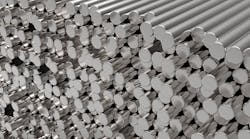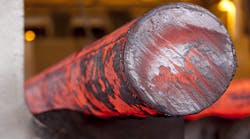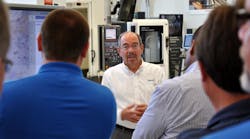All around the world component manufacturers are looking for new ways to increase productivity while driving down production costs — all without changing the quality or consistency of their products.
Achieving this is difficult. Steels that are optimized for machining can improve efficiency, production levels, and profit margins, and yet in some cases this comes at the cost of important qualities, like corrosion-resistance and mechanical strength. In other cases, machine shops have switched from carbon to stainless steels, but then discovered that machine speeds and settings had to be altered in order to avoid vibration, chatter, tool gumming, and poor chip breaks.
All this is changed with the Sandvik’s development of Sanmac stainless steels, which offer better machinability without compromising the material’s mechanical strength or corrosion-resistance, nor the operators’ tool settings. In doing so, these new materials open a window of opportunity for any manufacturer that must machine steel — and seeks to maximize the benefits.
Advantages of specialty machining steels — The Sanmac range of steels has been designed to give improved and more efficient machining. Sanmac steels have already proven their value in service: operators have achieved new machining speeds up to up 240 m/min as a result of the material’s consistency, insert development and enhanced cutting data.
A specific material is Sandvik Sanmac 2205, a machinability-improved duplex (austenitic-ferritic) stainless steel. The chart and graph shown below describe the recommended inserts and cutting values (starting values) for the grade. It has characteristics that distinguish it from other, more conventional, materials, largely due to an adjusted balance of sulfur levels and the addition of non-metallic inclusions.
As a result, Sanmac steels are more machinable than conventional materials, but they do not sacrifice the original grade’s corrosion resistance or other valuable qualities.
Sandvik Sanmac 2205 can withstand demanding turning processes better than austenitic options due to its enhanced mechanical strength. Although turning with normal austenitic 300 series material grades might seem easier, such materials are prone to poor chip breaks, exhibit poorer surface quality, and cannot withstand higher turning speeds. These conventional grades also are more vulnerable to corrosion, less able to tolerate impact at low temperatures, and are less weldable due to changes in mechanical strength.
Material properties of Sanmac — An important differentiating factor between Sanmac steels and conventional grades is the correct balance of micro inclusions, non-metallic defects that significantly enhanced control of the shape, size, and hardness of the material. In turn, this ensure Sanmac has exceptional workability, as well as outstanding mechanical and corrosion-resistant properties.
Sanmac duplex stainless steels also have good impact strength, at room temperature and low temperatures. According to NORSOK standards, when subjected to impact testing at -46°C (-51°F) Sanmac 2205 greatly exceeded the required values. The material also shows high levels of resistance to general corrosion, pitting, and crevice corrosion.
Sanmac 2205 is very resistant to stress corrosion cracking (SCC) with a Pitting Resistance Equivalent number of >35. The higher the PRE number, the greater will be the resistance to pitting.
Eliminate machining with hollow bar — Further advantages may be achieved by machining with hollow bar, in particular time and cost savings. Machining with hollow bar can expedite the machining of components such as valves, flanges, coupling, seals, flow meters, and pump bodies, and their associated parts. A notable advantage is that machining with hollow bar eliminates the need for a central bore, one of the most demanding machine operations, and use of hollow bar can eliminate some aspects this process entirely. The result is improved productivity and reduced costs: using Sanmac hollow bar has been shown to generate machine shop productivity gains of around 20%.
Further advantages of hollow bar for machine shops are that it is lightweight, is available in a range of sizes and dimensions, and Sanmac hollow bar permits faster machining. This means quicker production times and less tangled chips, because boring is minimized.
New developments — The range of possible new materials is increasing as Sandvik’s research and development team devises solutions that address existing problems and changing markets and needs. In the newest generation of Sanmac, Sandvik also has upgraded the melt. Thus, this new series of Sanmac is available in a range of grades that offer not only improved machinability, but also show excellent chip breaks and consistent machinability from heat-to-heat and lot-to-lot. This helps to reduce set-up times.
Cost savings — The development of these machinability-improved duplex (austenitic-ferritic) stainless steels is guided by machine shops’ determination to improve productivity, and Sandvik is well aware of that necessity, as well as to help firms meet the new production challenges.
Just as important is availability to customers. Machine shops and fabricators can select near-net-shape Sanmac solid or hollow bar in sizes and dimensions suited to their specific requirements. While customers may have the option to reduce their own stock of profiles, they also can take advantage of local Sandvik material stocks and better logistics.
Just as customers are able to reduce lead times by using near-net-shape bar with close dimensions of the finished part, they also can clear space for manufacturing, and/or release capital that might otherwise be tied up in materials. To help all operators minimize their costs in a similar way, Sandvik has produced an online tool, the Sandvik bar converter, which helps to estimate the savings that may be generated by a switch to hollow bar.
In challenging conditions where component manufacturers must do all they can to gain a commercial edge, Sanmac stainless steels offer an important advantage: it can generate faster machining, faster cutting speeds and feed rates, boosting the throughput of cutting machinery. For machine shops the result is lower per-unit cost of the item being machines, which can increase profit margins when the product is delivered.
Rinaldo Brivio is a machining applications specialist with Sandvik Materials Technology. Contact him at LinkedIn, or visit www.smt.sandvik.com for more information on the Sandvik Sanmac hollow bar stock program — including the Sandvik bar converter .
Sandvik and Sanmac are registered trademarks owned by Sandvik Intellectual Property AB.
